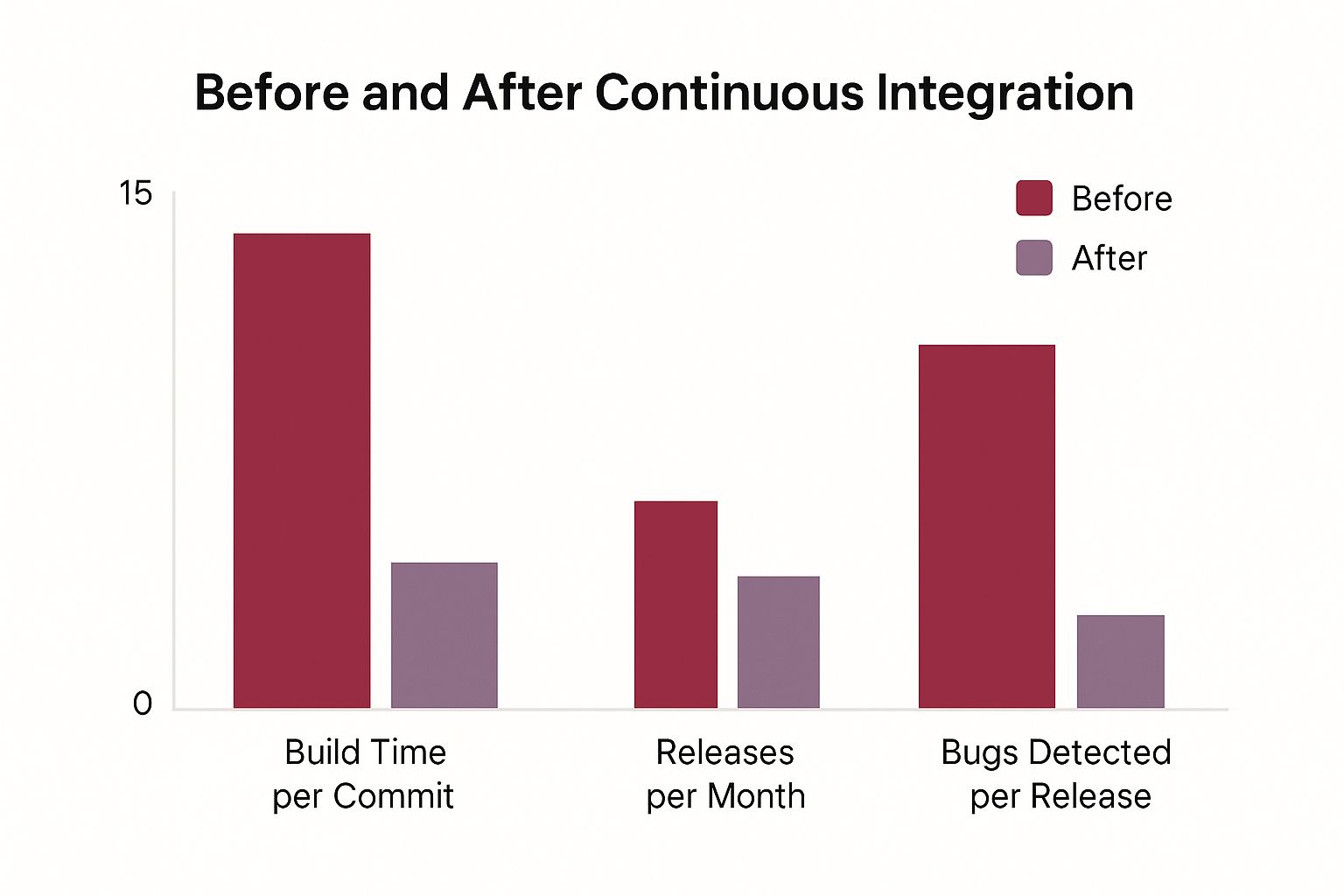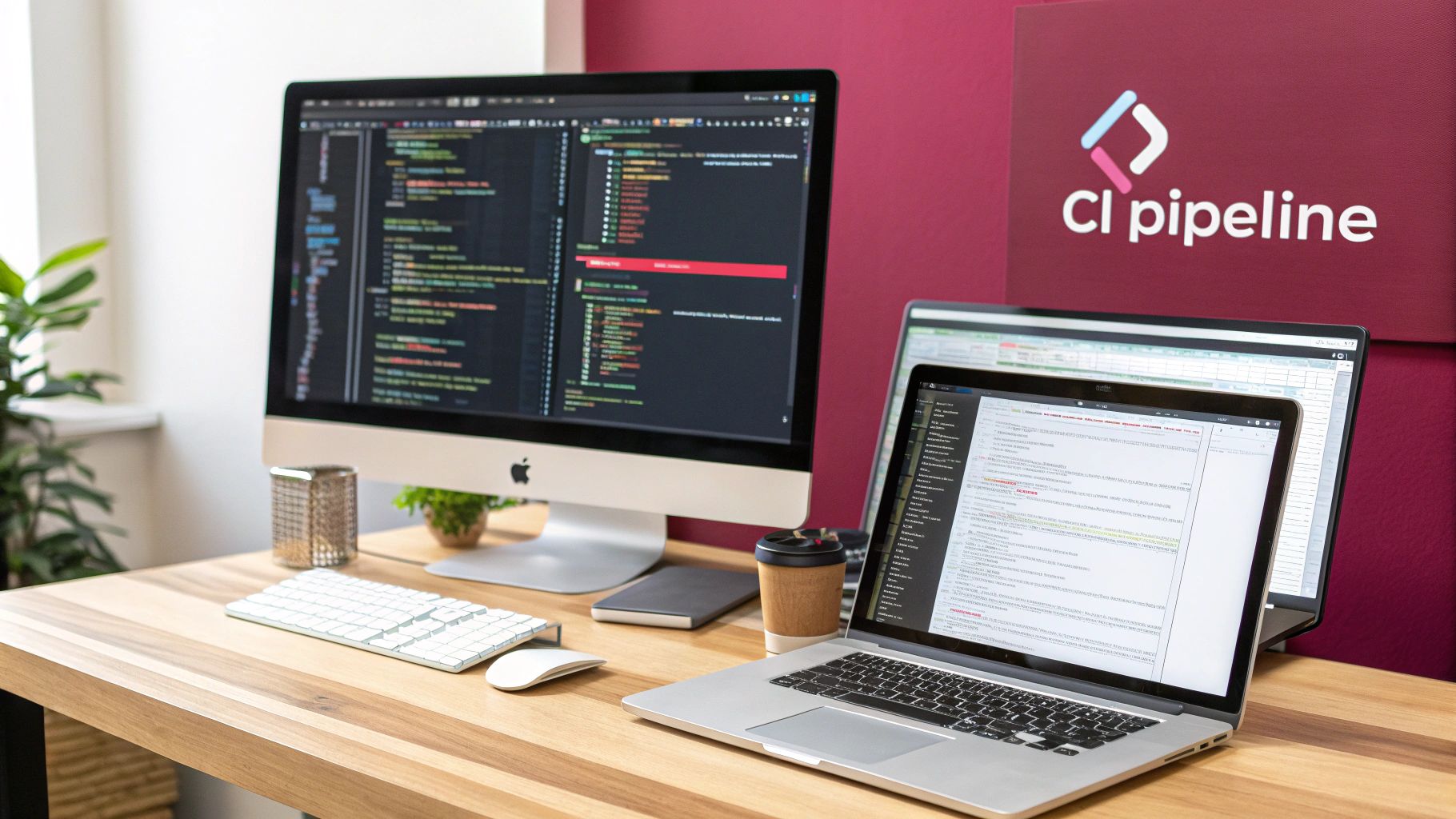Why React Native Continuous Integration Changes Everything
Manual testing and deployments can be a real drag on productivity. They’re time-consuming, prone to errors, and can easily become a bottleneck for your development team. React Native Continuous Integration (CI) offers a powerful solution to these common development hurdles.
React Native CI fundamentally changes the mobile development lifecycle by automating key processes. Building, testing, and deploying are all handled automatically, freeing developers to focus on writing high-quality code and delivering innovative features. Imagine pushing code changes that are then automatically built, tested across various devices, and deployed to a staging environment—all without manual intervention.
This automation translates into significantly faster release cycles. Teams using CI often see a 3x increase in shipping speed, enabling them to respond to market demands and user feedback much faster. Automated testing within the CI pipeline also catches bugs early, drastically reducing the number of issues that make it to production. This leads to a more stable, reliable app and an improved user experience.
Addressing the Challenges of React Native CI
React Native, however, presents unique challenges for CI implementation. From platform-specific builds (iOS and Android) to the complexities of testing on different devices and operating systems, successful CI integration requires addressing these nuances. A proper CI setup provides dedicated environments for building and testing different platforms, automating code signing and keystore management, and streamlining deployments.
Fostering Collaboration and Efficiency
Effective CI isn’t just about automation; it’s about fostering better collaboration. With CI, developers can work on features simultaneously and integrate their code seamlessly, reducing integration conflicts and improving overall team efficiency. The integration of Continuous Integration (CI) tools is crucial for React Native developers to ensure efficient development. CI plays a significant role in automating the testing, building, and deployment phases, which are essential for maintaining high-quality and scalable applications.
Looking ahead, React Native’s ability to support AI integration and faster development cycles is expected to further increase its popularity. This is particularly important as businesses focus on speed and cost in mobile app development, and React Native’s single codebase approach significantly reduces both development time and costs. Learn more about the importance of CI in React Native Development. The use of CI/CD pipelines in React Native projects helps ensure applications are consistently updated and maintained. All of this leads to increased productivity and reduced development costs—a significant advantage for any React Native project.
Choosing The Right CI Platform For Your React Native Project
Selecting the right Continuous Integration (CI) platform is critical for any React Native project. Not all platforms offer equal support for mobile development. Choosing hastily can waste time and resources. Let’s explore the strengths and weaknesses of popular options.
Popular CI Platforms for React Native
Several CI platforms are popular with React Native developers:
-
Bitrise: Designed for mobile app development, Bitrise excels at supporting React Native, including device testing and code signing.
-
CodeMagic: This mobile-focused CI/CD platform, CodeMagic, simplifies building, testing, and deploying React Native apps with its user-friendly interface and robust tools.
-
CircleCI: A well-established CI platform, CircleCI has broad language support and can be configured for React Native, though it may require more custom setup.
-
GitHub Actions: Tightly integrated with GitHub, Actions provides a convenient and cost-effective option, especially for smaller projects or those already using the GitHub ecosystem.
Key Considerations for Platform Selection
Consider these factors when evaluating platforms:
-
React Native Support: Look for dedicated features for building, testing, and deploying React Native apps. Native module compilation, iOS provisioning, and Android keystore management are essential. Bitrise and CodeMagic offer strong support for these mobile requirements.
-
Cost: CI platforms range from free tiers to enterprise pricing. Choose a platform that fits your budget.
-
Team Size: Some platforms are better for smaller teams, while others scale for larger organizations. GitHub Actions can be a good start for small teams, while Bitrise scales for larger projects.
-
Technical Needs: Consider your app’s complexity and customization needs. Some platforms offer pre-built workflows for easy setup, others provide flexibility for complex builds.
To help you compare these leading CI platforms, we’ve compiled a table summarizing key features, costs, and React Native capabilities based on real-world team feedback:
React Native CI Platform Comparison Guide
Real-world comparison of leading CI platforms showing features, costs, and React Native-specific capabilities based on team feedback
| Platform | React Native Support | Monthly Cost | Standout Features | Best Team Size |
|---|---|---|---|---|
| Bitrise | Excellent, dedicated mobile features | Varies, free tier available | Device testing, code signing | Small to Large |
| CodeMagic | Excellent, mobile-first approach | Varies, free tier available | Easy setup, robust tooling | Small to Medium |
| CircleCI | Good, configurable but requires setup | Varies, free tier available | Broad language support | Medium to Large |
| GitHub Actions | Good, integrates with GitHub ecosystem | Varies, free tier available | Cost-effective, convenient for GitHub users | Small to Medium |
This table highlights the strengths of each platform. Bitrise and CodeMagic offer robust mobile-specific features. CircleCI provides broader language support. GitHub Actions is a convenient, cost-effective choice for GitHub users.

The infographic above shows the positive impact of continuous integration. Build time per commit decreases from 15 minutes to 5 minutes. Releases per month increase from 1 to 4. Bugs per release drop from 25 to 5. This demonstrates the efficiency gains of CI. For further reading, check out this article on How to master React Native CI/CD.
Choosing the right CI platform for your React Native project is essential for an efficient workflow and timely delivery of high-quality apps. Careful evaluation of your needs and platform features will streamline your development process.
Building Your First React Native CI Pipeline That Actually Works
So, you’re ready to automate your React Native testing and embrace Continuous Integration (CI)? This guide will help you build a functional CI pipeline from scratch. We’ll cover setting up your environment, managing dependencies, and addressing security concerns effectively.
Setting Up Your Environment
First, choose a CI platform. Popular options include Bitrise, CodeMagic, CircleCI, and GitHub Actions. Each platform has its own pros and cons. Consider your team’s size, budget, and technical requirements when making your decision. If your team primarily uses GitHub, GitHub Actions might be the most convenient and affordable choice. If your project needs specialized mobile features, Bitrise or CodeMagic might be better suited.
Managing Dependencies and Security
Next, configure your chosen platform to handle React Native’s specific needs. This includes native module compilation, iOS provisioning, and Android keystore management. Securely storing your signing certificates and API keys is essential. These credentials are highly sensitive and require careful protection, similar to how you’d safeguard a physical key to your office.
Structuring Your Pipeline for iOS and Android
Now, structure your pipeline for both iOS and Android builds. This involves defining the automated steps your CI platform will execute. A typical pipeline might include:
- Install dependencies:
npm installoryarn install - Run linters: Use tools like ESLint to maintain code quality.
- Run tests: Execute unit, integration, and end-to-end tests.
- Build the app: Generate the
.apk(Android) and.ipa(iOS) files. - Code signing: Sign your app for distribution.
- Deploy: Release your build to app stores or a distribution platform.
For more in-depth information, check out this helpful resource: How to master continuous integration.
Handling Code Signing and Automated Testing
Code signing can be a significant challenge in mobile development. Your CI platform should streamline this process, automating the signing of your builds for distribution. Automated testing is also vital for catching regressions early. A comprehensive testing strategy incorporates unit, integration, and end-to-end tests. This layered approach provides maximum test coverage and ensures app stability with every change. Think of it as building a house: unit tests check individual bricks, integration tests verify the walls, and end-to-end tests confirm the entire structure is sound.
Scaling Your Pipeline
Your CI pipeline should adapt to your project’s growth. As your team expands and the app becomes more complex, adjust your pipeline accordingly. You might add stages for performance testing or security scans. This proactive approach ensures your pipeline remains effective and valuable to your workflow. By following these steps, you’ll create a robust and scalable React Native CI pipeline, freeing up your time to focus on developing great features for your users.

Testing Strategies That Work In Real CI Environments

Effective testing in a Continuous Integration (CI) environment for React Native goes beyond simply automating your existing tests. It involves developing a comprehensive testing strategy that ensures code quality without impacting your pipeline’s efficiency. This requires striking a balance between different testing types.
The Testing Pyramid for React Native
The testing pyramid offers a valuable model for structuring your test suite. At its base are unit tests, which target individual components or functions in isolation to ensure they function correctly. Above unit tests are integration tests. These verify the interactions between multiple components, confirming they work together as expected. Finally, at the peak, are end-to-end (E2E) tests. E2E tests simulate real user interactions, providing a comprehensive view of your application’s functionality.
This layered approach is vital for React Native CI. A well-structured suite might include a large number of fast unit tests, fewer integration tests focusing on key interactions, and a small number of critical E2E tests to verify the overall user experience. This balance ensures comprehensive coverage without slowing down your CI pipeline. For further information on CI testing, you can check out this resource: How to master testing in continuous integration.
To understand the practical implications of choosing a testing framework, let’s examine a comparison of popular options. The following table illustrates the differences in setup, maintenance, and learning curve for each framework.
React Native Testing Framework Decision Matrix
| Framework | Test Coverage | CI Setup Time | Maintenance Level | Team Learning Curve |
|---|---|---|---|---|
| Jest | Unit & Integration | Low | Low | Low |
| Detox | E2E | Moderate | Moderate | Moderate |
| Appium | E2E | High | High | High |
This table highlights the strengths and weaknesses of each framework. Jest excels in its ease of setup and low maintenance overhead, making it ideal for unit and integration tests. Detox, while requiring more setup effort, provides valuable insights into real-world user behavior. Appium offers broad platform support but comes with higher maintenance and learning curve. Choosing the right framework depends on your specific project needs and resources.
Effective Testing Tools and Techniques
Jest is a common choice for unit and integration testing in React Native. Jest is easy to configure, integrates well with React, and offers features like snapshot testing, which simplifies UI testing by capturing and comparing component output.
For E2E testing, Detox is a powerful framework specifically designed for mobile. Detox allows you to simulate user interactions on both real devices and simulators, providing confidence in real-world app behavior. While configuring Detox for CI can be complex, the resulting confidence in your releases is significant.
Optimizing Your Test Suite for CI
Efficient test execution within CI is critical. Parallel testing, running multiple tests concurrently, drastically reduces testing time. Managing flaky tests, tests that yield inconsistent results without code changes, is also crucial. Flaky tests undermine confidence in your CI process and can halt deployments. Robust test reporting provides essential feedback to your team, identifying issues and speeding up debugging. Effective reporting goes beyond simply listing passed or failed tests; it offers insights into your codebase’s overall health.
Leveraging Community Power For Faster CI Implementation
Building a React Native Continuous Integration (CI) pipeline from scratch can be a daunting task. Fortunately, the active React Native community provides a wealth of resources that can significantly simplify and speed up the process. Why start from scratch when effective solutions already exist?
Tapping into the Ecosystem
The React Native community offers numerous tools, pre-built configurations, and established workflows to kickstart your CI implementation. Open-source projects on platforms like GitHub provide readily available CI configurations adaptable to your specific project needs. These configurations often incorporate industry best practices and solutions to common challenges, saving you valuable time and effort.
Community-driven libraries also offer pre-built solutions for common CI tasks. These include processes like code signing, testing, and deployment. Integrating these libraries into your pipeline can greatly reduce the complexity of setting up these crucial processes.
React Native’s popularity stems not only from its technical capabilities but also its thriving community. The growth in community-driven libraries and open-source solutions is a testament to this. For instance, there’s been a 35% year-over-year growth in such libraries on platforms like GitHub. This active development and utilization of shared resources accelerates development and innovation. This community support is essential for continuous integration, allowing developers to easily find and integrate new features and tools. More detailed statistics can be found here. You might also find this article helpful: How to master continuous integration on Android.
Evaluating and Integrating Community Resources
While leveraging community resources is beneficial, careful evaluation is essential. Make sure any library or configuration you integrate aligns with your project’s specific security requirements.
Thoroughly review the source code and documentation to understand potential risks and dependencies. Prioritize well-maintained projects with active communities and regular updates. This due diligence helps ensure you avoid vulnerabilities and integrate reliable, secure solutions.
Contributing Back to the Community
Just as you benefit from community resources, consider giving back. Sharing your own configurations, scripts, or tools strengthens the ecosystem and benefits other developers.
This collaborative spirit fosters a shared learning environment and accelerates innovation within the React Native community. Building upon proven solutions, instead of starting from scratch, lets you focus on your project’s unique aspects. You can do this while ensuring a stable and efficient CI pipeline. This community-driven strategy is key to creating more robust and maintainable pipelines, ultimately expediting your React Native CI journey.
Why React Native’s Growth Makes CI Investment Essential
React Native has quickly become a major player in cross-platform mobile development, evolving from an internal Facebook tool to a widely adopted framework. This rapid growth significantly impacts how development teams should approach Continuous Integration (CI). Understanding this evolution reveals why a robust CI strategy is essential for staying competitive.
React Native’s expanding ecosystem offers a wealth of tools and libraries, creating new opportunities for CI optimization. Teams can use these resources to automate processes, improve testing, and deliver high-quality apps faster. This directly translates to a stronger market position and happier users.
Many companies choose React Native for its faster time-to-market. However, this speed can be lost without a solid CI/CD pipeline. Robust CI ensures that rapid development doesn’t compromise quality or stability, enabling frequent releases while minimizing bugs. Check out our guide on How to master continuous integration on iOS.
React Native is a leading cross-platform development platform with a growing market share. In 2024, it reached 6.75%, up from 4.73% in 2022. This makes it the top non-native framework on the App Store and the second most popular on Google Play. This growth highlights React Native’s efficiency and cost-effectiveness, especially when integrating new technologies like AI and augmented reality. Learn more about cross-platform mobile development trends.

The Impact of Market Presence on Tooling
React Native’s growing market presence influences tooling decisions. As the platform matures, CI platforms increasingly offer dedicated support, including streamlined builds, automated code signing, and robust testing integrations. Choosing the right CI tools helps teams optimize their workflows.
Positioning Your Team for Success
Investing in a strong CI/CD pipeline is not just about keeping pace; it’s about preparing for future innovations. As React Native evolves, robust CI will be crucial for integrating new features, adapting to market changes, and maintaining a competitive edge. This proactive approach empowers teams to build better apps, release more frequently, and deliver greater user value.
Key Takeaways For React Native CI Success
Successfully implementing Continuous Integration (CI) for your React Native project requires a well-defined strategy and a deep understanding of the platform’s unique challenges. This section distills key takeaways to guide you towards building a robust and effective CI system.
Essential Practices for a Solid Foundation
-
Choose the Right CI Platform: Select a platform that offers strong React Native support. Consider factors like native module compilation, iOS provisioning, and Android keystore management. Dedicated mobile CI platforms like Bitrise and CodeMagic excel in these areas. Don’t underestimate the importance of tight integration with your version control system, such as the seamless connection between GitHub Actions and GitHub.
-
Build a Well-Structured Pipeline: Structure your pipeline for both iOS and Android, incorporating steps like dependency installation, linting, testing, building, code signing, and deployment. Think of your CI pipeline as an assembly line, with each step meticulously crafted to contribute to the final product: a high-quality, thoroughly tested app.
-
Implement a Comprehensive Testing Strategy: Follow the testing pyramid by including unit, integration, and end-to-end tests. Jest provides an excellent framework for unit and integration tests. For end-to-end testing, Detox offers a robust solution specifically designed for mobile environments. Aim for a balance: a solid foundation of unit tests, a supporting structure of integration tests, and a capstone of E2E tests.
Optimizing Your CI Workflow
-
Leverage Community Resources: Tap into the vast React Native community for pre-built configurations, tools, and best practices. Thoroughly evaluate and integrate community resources to accelerate your CI implementation while adhering to security best practices. Think of your CI pipeline as a customized car: use readily available, high-quality parts from the community (libraries, tools, etc.) to avoid building everything from scratch, but ensure they’re compatible with your design and security requirements.
-
Automate Key Processes: Automate as much as possible, from dependency management to code signing, testing, and deployment. Automation is the cornerstone of efficient CI, minimizing manual intervention and allowing your team to focus on development.
-
Monitor and Measure: Implement robust monitoring and reporting to identify issues, measure CI effectiveness, and continuously optimize your pipeline. Track metrics like build time, test coverage, and error rates. Use tools like Sentry and Datadog for real-time insights into application performance and potential issues.
Long-Term Success with React Native CI
-
Embrace the React Native Ecosystem: Stay up-to-date with the latest advancements in React Native and leverage the evolving ecosystem to enhance your CI capabilities. The platform’s growth means continuous improvement in tooling and community support.
-
Plan for Scalability: Ensure your CI system can scale with your project’s growth. Anticipate future needs, like performance and security testing, and adapt your pipeline proactively. Design your CI/CD pipeline like a well-planned city: it should have the infrastructure to accommodate growth and change while continuing to operate efficiently.
-
Invest in Your Team: Dedicate resources for CI implementation and maintenance. Train your team on CI best practices. Effective CI isn’t just about tools; it’s about fostering a culture of continuous improvement.
By adopting these key takeaways, you’ll create a React Native CI system that not only automates essential processes but also enhances app quality, accelerates development, and positions your team for long-term success.
Ready to take your React Native deployments to the next level? CodePushGo streamlines your over-the-air updates, empowering you to ship bug fixes and features faster and more securely. Learn more about how CodePushGo can transform your release process.




